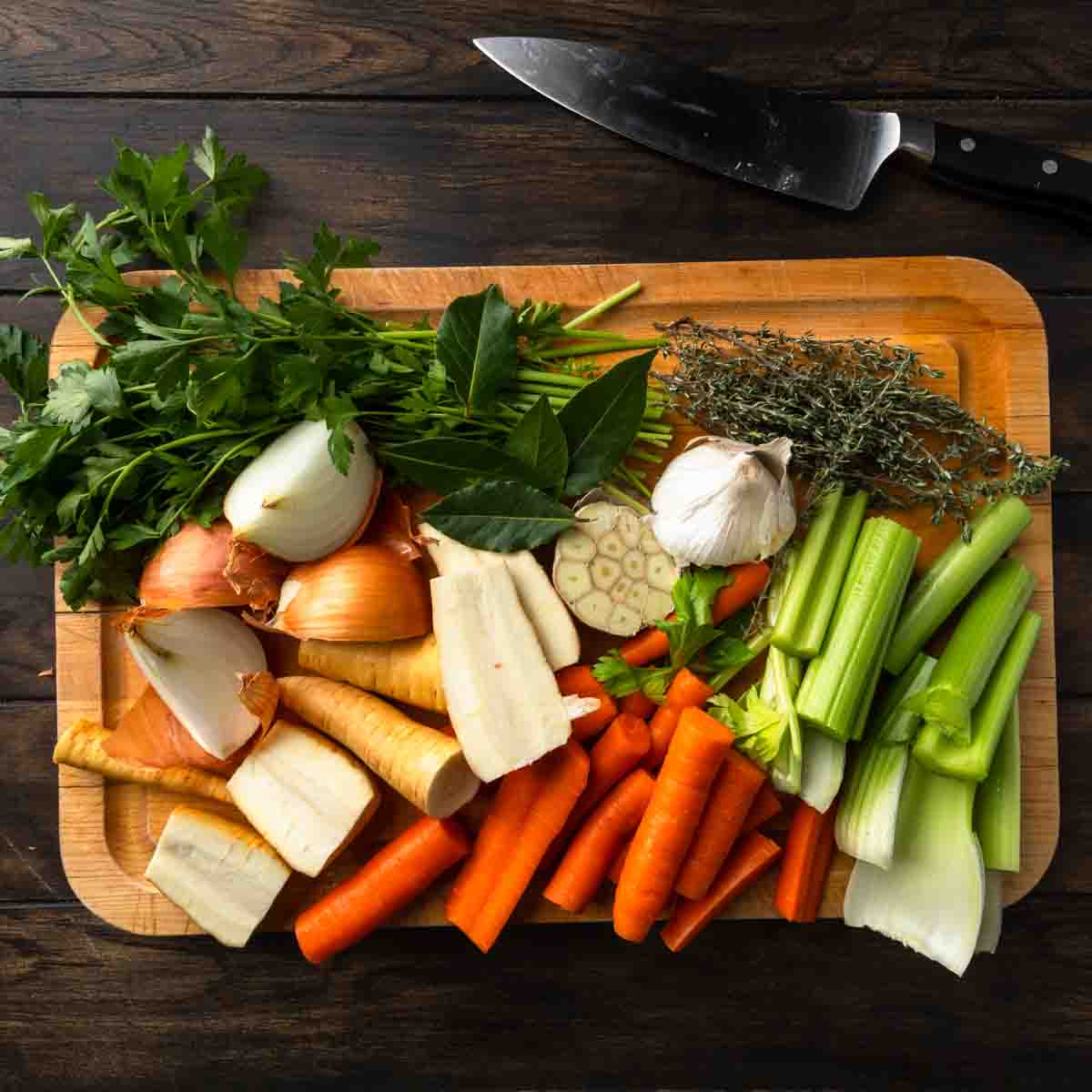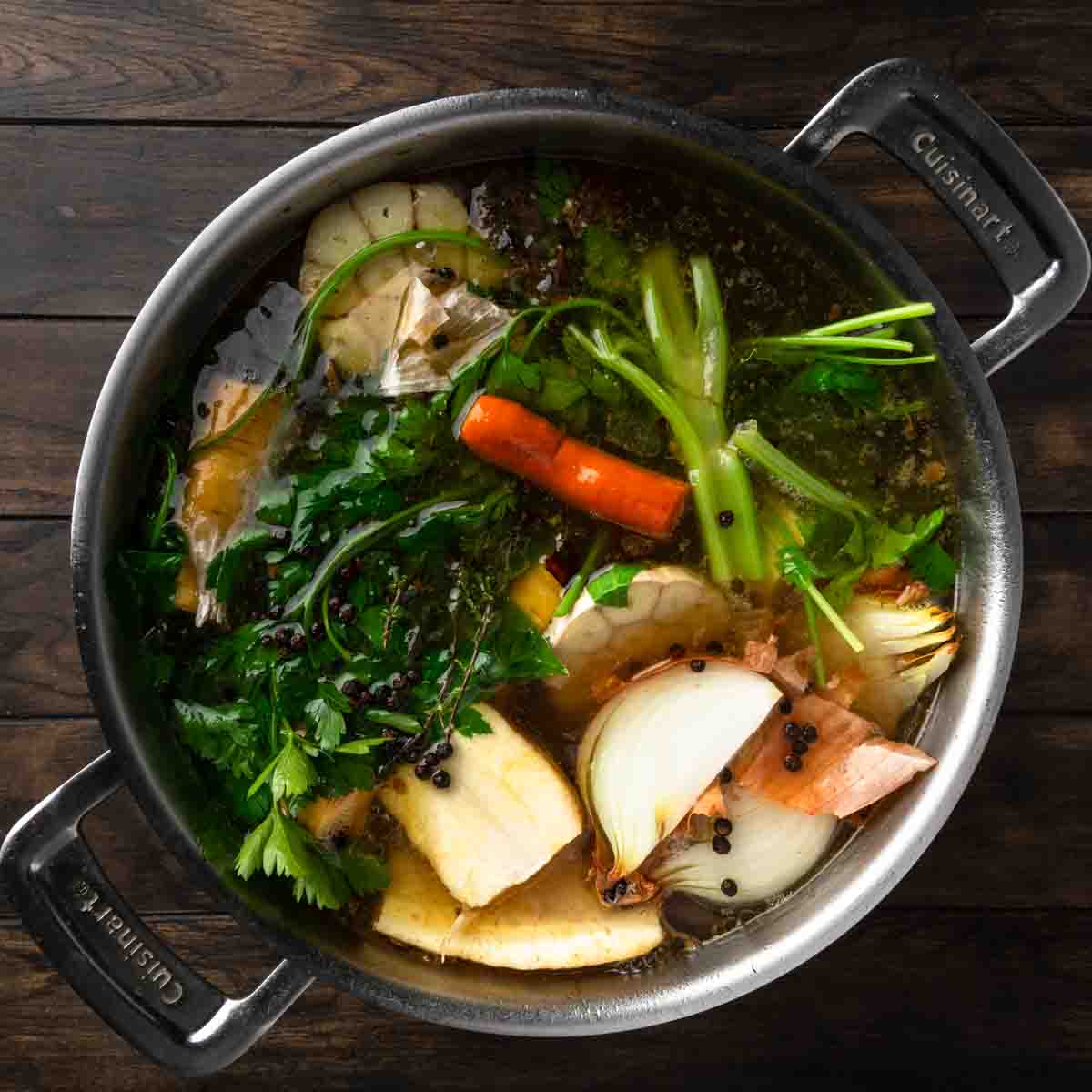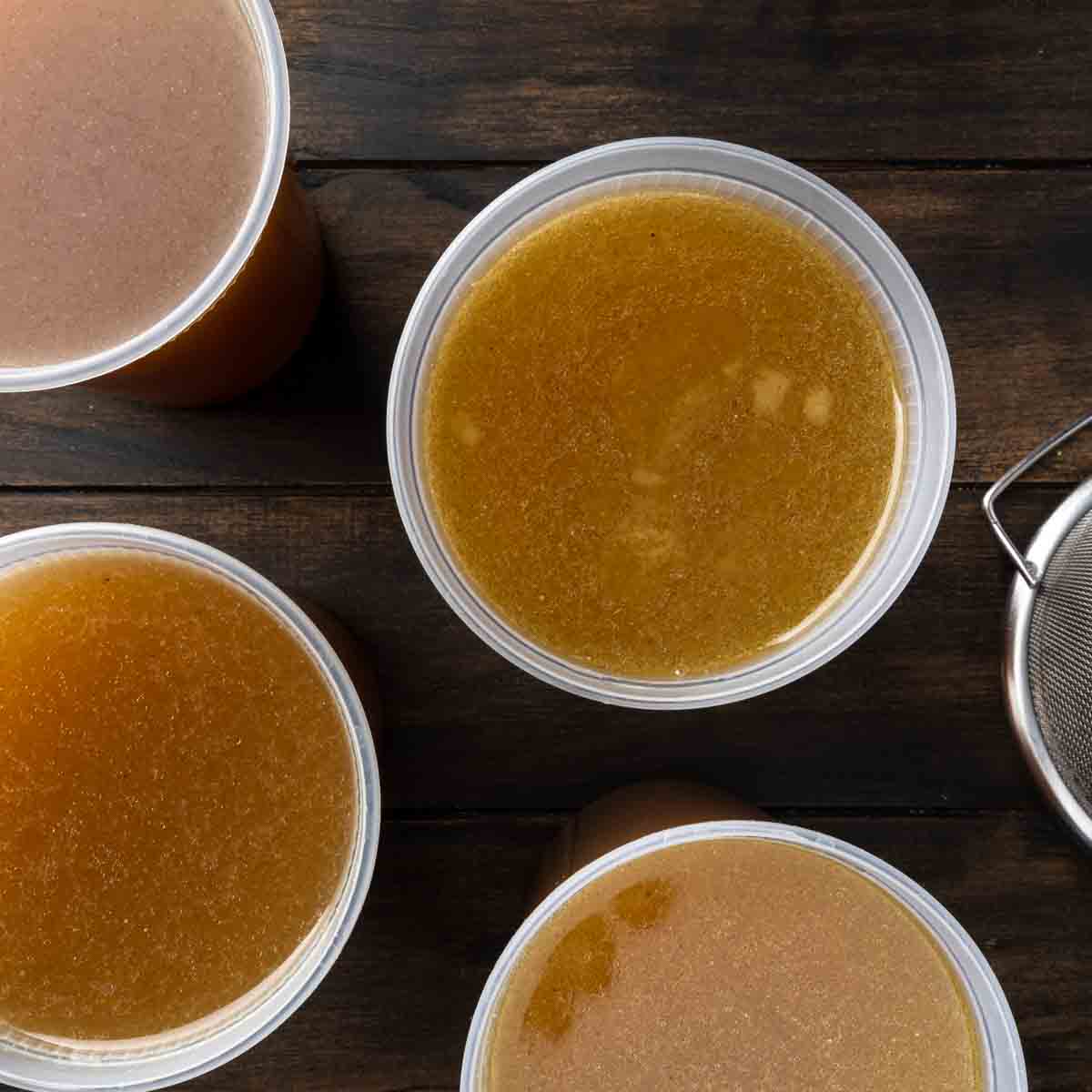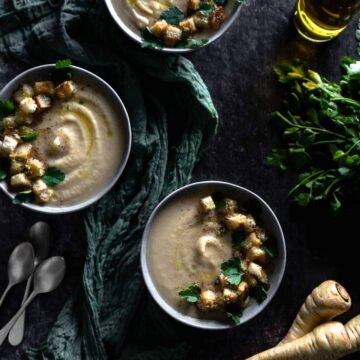The key to a fabulous and flavorful Thanksgiving meal is a really great stock. This turkey stock is a simple recipe that I like to make each November in preparation for a big Thanksgiving feast. It's better than anything you'll find in the store and can be used to make the best make-ahead turkey gravy, to moisten your stuffing, and in all your favorite holiday recipes.

Homemade stock simmering on the back of the stove while the warm scents fill the kitchen is one of my life's greatest pleasures. It something so simple that warms my soul and adds that incredible home-cooked depth of flavor that you just can't get from opening a can. It takes some time but it's the simplest of recipes and something I would encourage everyone to try for themselves.
Jump to:
Ingredients
This recipe is made with turkey wings and a turkey neck, if you have one. I love using wings for this recipe because they are inexpensive, have a great surface area for roasting golden and full of flavor, and have just the right amount of fat (which can be saved for making the tastiest turkey gravy)! If you can't find turkey wings, you can use chicken wings and/or other chicken or turkey parts like backs, necks and bones.

- Turkey Wings & Neck - You can also add turkey (or chicken) backs and/or bones
- Aromatic Vegetables - Onions, celery, carrots, parsnips (optional), and garlic
- Fresh Herbs - Parsley, thyme and bay leaves
- Peppercorns
- Cold Water
Pro Tip: Don't Bother Peeling Your Onion or Garlic - Once in a while I'll have a reader be surprised to see that some of my recipes use unpeeled onion or garlic, but it's for good reason! Onion and garlic skins pack a ton of flavor and nutrients. The onion skins also lend a deep color, like natural dye, to homemade stock. They're pesky to peel and will be strained out anyways - so, when making stock, don't bother peeling!
How To Make Homemade Turkey Stock
While this stock does require some time, the process is incredibly easy and the majority of the time is hands-off.
- Start by patting your turkey parts dry with a paper towel. Drizzle them in olive oil and season them generously with salt and pepper. Roast the turkey in a hot oven for 60 - 90 minutes, flipping halfway through, or until the skins are roasted golden brown. (If using chicken wings, this process will be much quicker.)


- Transfer the roasted turkey into a large stock pot. Pour a splash of water on the roasting pan and use a flat spatula to scrape up any of the browned bits and turkey fat (this is where all the flavor is). Add all of the browned bits and fat from the baking sheet into your stockpot. Cover the turkey with a total of 6 quarts of cold water. Bring to gentle simmer on the stove.


Pro Tip: Low and Slow for Clear and Clean - The best way to cook a broth or stock is low and slow. Do not boil! You want to cook this broth on very low heat to maintain the gentlest of simmers - one where the stock bubbles every 3 - 5 seconds.
This method gently steeps the ingredients into a flavorful "tea", and you won't boil and steam away all of your broth. If your broth boils, it's okay, but the fats will emulsify into the stock creating a cloudy colored broth.
- Slowly simmer the turkey stock for 2 - 3 hours, as time allows.
- In the meantime, prep your veggies and aromatics. Quarter your onions, skin on. Wash and cut the carrots, celery, and parsnips and cut into 3 or 4 segments. Halve an entire head of garlic. Prepare a generous handful of fresh parsley, and thyme. (You can add sage or rosemary too, if you'd like to.) Add everything into the stock pot with a Tablespoon of black peppercorns and 5 fresh (or 3 dried) bay leaves.
- Your pot may be very full, and that's okay. Gently submerge the ingredients into the stock. Continue simmering gently for an additional 2 - 3 hours.


- After your second long simmer, the stock is ready. Use tongs to remove the turkey parts and any large vegetables. The turkey meat will likely be a bit overcooked and lacking flavor, so I've justified discarding it. If you'd like, you can pull the meat and add it to soups, enchiladas, meat pies or other recipes with lots of flavor. Otherwise, discard the meat with the vegetables and wilted herbs.
- Strain the stock through a fine mesh strainer to remove any fine particles. You should have about 1 gallon of stock. You can season it with additional salt now, or leave it as is, lightly seasoned, to use in various recipes. I like to divide my stock into quart containers and refrigerate, or freeze, as needed.

- Once cooled, the turkey fat will rise to the surface of the stock. Skim and reserve the fat to use in the roux for turkey gravy. You can also add it to biscuits, or use it to flavor and cook your green vegetables.
Pro Tip: Proper Cooling for Safe Eating
It is very important that the stock is completely cooled to a safe temperature. Since this is a big pot of stock, it can easily stay too warm for too long and become the perfect playground for pesky bacteria. To ensure your stock is safe to cook with and eat, follow these food safety guidelines:
- The stock should be left at room-temperature for up to 2 hours. (Off of the stove, on your countertop.) Don't put the whole hot pot directly in the fridge - it will heat your entire fridge up!
- Refrigerated and cooled to below 41° Fahrenheit within 4 hours (after refrigerating).
To ensure your stock cools quickly I recommend straining the stock within the first two hours and transferring the broth into smaller containers. Shallow metal containers full of broth will cool faster than plastic.
Saving & Storing
This stock can be safely stored in the fridge or freezer until you are ready to use it. I like to make a double batch sometime in early November and keep it frozen in quart bags (or deli containers) to use for my Thanksgiving dinner.
- Refrigerator: 4 - 5 days
- Freezer: 2 - 3 months (or more!)

How To Use Turkey Stock
This stock recipe can be used anywhere you would cook with chicken broth or stock. It's also the base for the best make-ahead turkey gravy to be served on Thanksgiving and throughout the holiday season. Here are our top uses for turkey stock:
- Turkey gravy - Our favorite way to enjoy this recipe 🙂
- Stuffing/Dressing - We use this stock to moisten our favorite challah and sausage stuffing every year.
- Soups - This stock makes for the most flavorful soups and stews. You can use it for a Thanksgiving leftover turkey noodle soup or something a bit richer, like our creamy chicken and wild rice soup.
- Braising liquid - Add flavor to your braises by using homemade stock in classic dishes like Southern style braised greens, coq au vin blanc or seasonal foods like our cider braised chicken thighs.
- Pan sauces - You can use turkey stock to deglaze a pan for a quick sauce for chicken, turkey, pork chops and more.
I have big Thanksgiving with lots of guests (usually 20+) - I typically make a double batch of stock and use half for gravy and half in other recipes. Any remaining stock goes into our leftover Thanksgiving soup.

Frequently Asked Questions
Stock is typically made from boiled bones, often with onions, carrots, celery and/or other aromatics. Broth is very similar, but is made from boiled meat, onions, carrots, celery and/or other aromatics.
In almost all cases, broth and stock create a very similar product that can be used interchangeably.
If you cannot find turkey wings, you can make this recipe using chicken wings. For a richer, more gelatinous broth, try our chicken feet bone broth recipe.
Cloudy stock or broth is the result of boiling the liquid and cooking it at too high of a temperature. When boiling, the fat particles emulsify into the liquid, creating a cloudy appearance. The stock or broth will still taste delicious and can be used in the same way. For a clear stock, simmer very gently.
More Holiday Recipes...
Recipe

Make Ahead Turkey Stock (for Gravy, Stuffing & Soups)
ADJUST SERVINGS
Special Equipment
- Large Stock Pot
Ingredients
- 4 pounds turkey wings and turkey neck/ back, if you have one
- 2 - 3 Tablespoons olive oil as needed
- fine kosher salt* to taste, as needed for seasoning the turkey and finished stock
- Freshly-ground black pepper 1 - 2 teaspoons, as needed for seasoning the turkey
- 6 quarts cold water
- 2 medium yellow onions quartered, skins on
- 3 - 5 stalks celery cut in 4 inch segments
- 3 - 5 medium carrots cut in 4 inch segments
- 2 - 4 medium parsnips cut in 4 inch segments, optional
- 1 head garlic halved, skins on
- ½ bunch fresh parsley
- 1 handful fresh thyme
- 5 fresh bay leaves or 3 dried bay leaves
- 1 Tablespoon black peppercorns
Instructions
- Arrange a rack in the center third of the oven and preheat to 425° Fahrenheit (220° celsius). Season your turkey wings (and other parts, if using) with olive oil, salt and pepper. Arrange the turkey on a baking sheet and roast for 75 - 90 minutes, flipping halfway through, or until the turkey is roasted golden brown.4 pounds turkey wings + 2 - 3 Tablespoons olive oil + fine kosher salt* + Freshly-ground black pepper
- Use tongs to transfer the turkey wings and parts into a large stock pot. Pour a small amount of the cold water on your baking sheet tray and use a flat spatula to scrape up any browned bits and turkey fat from the pan. Transfer everything from the pan into the stock pot. Cover with the remaining cold water. Bring to a gentle simmer, with bubbles appearing every 3 - 5 seconds, for 2 - 3 hours. In the meantime, prepare your vegetables.6 quarts cold water
- After 2 - 3 hours, add your vegetables and aromatics to the stock pot. The pot may be very full, and that's okay. Gently submerge the ingredients in the water and continue simmering gently for an additional 2 - 3 hours.2 medium yellow onions + 3 - 5 stalks celery + 3 - 5 medium carrots + 2 - 4 medium parsnips + 1 head garlic + ½ bunch fresh parsley + 1 handful fresh thyme + 5 fresh bay leaves + 1 Tablespoon black peppercorns
- Use tongs to remove the turkey wings and any large vegetables from the pot. Save or discard, as desired. Strain the stock through a fine mesh strainer. Season with additional salt, if desired, or keep lightly seasoned to use in various recipes (recommended). Cool the stock completely. Use the stock immediately, or refrigerate or freeze until ready to use.fine kosher salt*
Notes
* A Note About Salt
Unless otherwise noted, all recipes on The Sage Apron are developed using Diamond Crystal Kosher salt. It is a great all-purpose salt for cooking and baking. If using table salt, reduce quantities by about half.






















Comments
No Comments